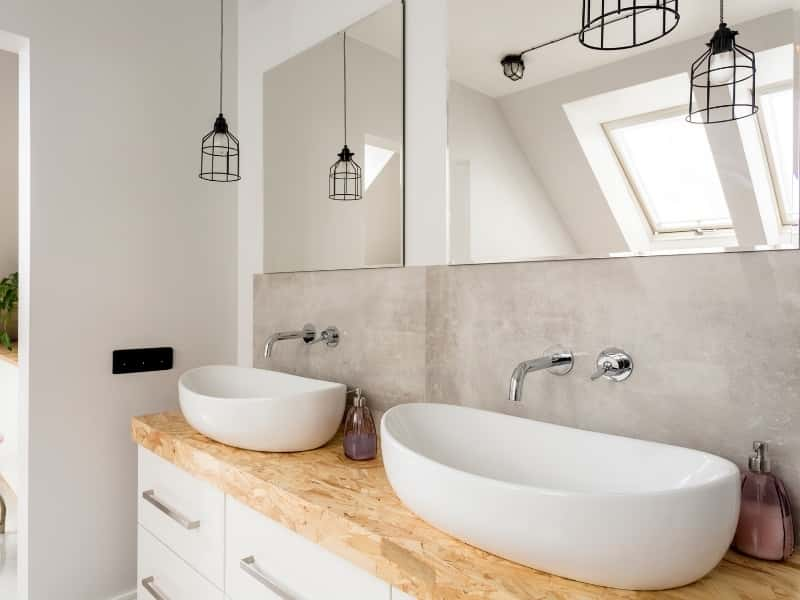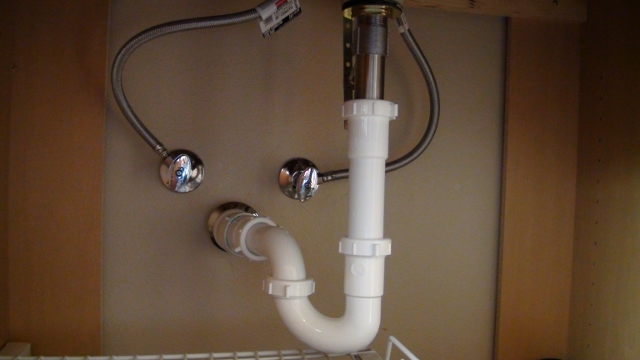If you've ever looked under your bathroom sink, you may have noticed a strange curved pipe leading from the drain. This is known as a P trap and is a crucial component of the plumbing system in your bathroom. But do bathroom sinks really need a P trap? The short answer is yes, and in this article, we'll explore the reasons why.Do Bathroom Sinks Need a P Trap?
The main purpose of a P trap is to prevent sewer gases from entering your home. Without a P trap, these noxious fumes would be able to escape through the drain and cause unpleasant odors in your bathroom. Additionally, P traps also catch debris and prevent it from clogging your pipes. They also create a water seal that prevents pests and insects from entering your home through the plumbing system.Why Do Bathroom Sinks Need a P Trap?
If you're installing a new bathroom sink or replacing an old P trap, here's a quick guide on how to do it. First, you'll need to purchase a P trap that is the correct size for your sink. Next, remove the old P trap by loosening the nuts that hold it in place. Then, place the new P trap under the sink and tighten the nuts to secure it. Finally, connect the P trap to the drain and the wall pipe using a rubber washer and nut. Make sure all connections are tight to prevent leaks.How to Install a P Trap for a Bathroom Sink
Aside from preventing sewer gases and debris, P traps offer other benefits for bathroom sinks. They can also reduce noise from water flowing through the pipes and help maintain proper water pressure. Additionally, P traps are relatively inexpensive and easy to install, making them a convenient choice for any bathroom sink.Benefits of Using a P Trap for Bathroom Sinks
While P traps are essential for maintaining a healthy plumbing system, they can also encounter some common problems. One of the most common issues is a clog caused by debris buildup. This can be prevented by regularly cleaning the P trap and using a hair catcher in the drain. Another issue is leaks, which can be caused by loose connections or worn out washers. These can easily be fixed by tightening the connections or replacing the washers.Common Problems with P Traps in Bathroom Sinks
If you notice that your P trap is damaged or leaking, it's important to replace it as soon as possible. To do this, follow the same steps as installing a new P trap. However, if you're not comfortable doing it yourself, it's best to hire a professional plumber to ensure it's done correctly.Replacing a P Trap for a Bathroom Sink
As mentioned earlier, the main purpose of a P trap is to prevent sewer gases from entering your home. These gases can be harmful to your health and can also cause unpleasant odors. P traps also catch debris and prevent it from clogging your pipes, which can lead to costly repairs. Understanding the importance of a P trap can help you maintain a healthy and functioning plumbing system in your bathroom.Understanding the Purpose of a P Trap in Bathroom Sinks
When it comes to choosing a P trap for your bathroom sink, there are a few factors to consider. First, make sure to measure the diameter of your sink's drain to ensure you purchase the correct size P trap. Additionally, consider the material of the P trap. Plastic P traps are more affordable, but may not be as durable as metal ones. It's also important to check the warranty and read reviews to ensure you're getting a quality product.Choosing the Right P Trap for Your Bathroom Sink
To ensure your P trap continues to function properly, it's important to regularly clean and maintain it. This involves removing any debris that may have accumulated and checking for any leaks or loose connections. You can also use a mixture of baking soda and vinegar to clean the P trap and keep it smelling fresh. It's also a good idea to check the P trap regularly for any signs of damage and replace it if necessary.Maintaining and Cleaning P Traps in Bathroom Sinks
You may have heard of S traps, which are similar to P traps but have a different shape. So, which one is better for bathroom sinks? The answer is that it depends on your plumbing setup. S traps are typically used in older homes, while P traps are more common in modern homes. It's best to consult a plumber to determine which type of trap is best for your specific plumbing system.P Trap vs S Trap: Which is Better for Bathroom Sinks?
The Importance of P-Traps for Bathroom Sinks

The Basics of P-Traps
 P-traps are an essential component of any plumbing system, especially in bathrooms. They are curved pipes that are designed to prevent harmful gases from entering your home and to block any debris from clogging your pipes. P-traps are required by building codes and are a necessary safety measure for any bathroom sink installation.
P-traps are an essential component of any plumbing system, especially in bathrooms. They are curved pipes that are designed to prevent harmful gases from entering your home and to block any debris from clogging your pipes. P-traps are required by building codes and are a necessary safety measure for any bathroom sink installation.
The Role of P-Traps in Bathroom Sinks
 P-traps serve several important functions in bathroom sinks. They create a water seal that blocks sewer gases from entering your home. These gases can be toxic and can cause health problems if inhaled. P-traps also prevent debris, such as hair and soap scum, from clogging your pipes. Without a P-trap, these materials can easily build up and cause blockages, leading to costly plumbing repairs. In addition, P-traps also help to regulate water flow, ensuring that your sink drains properly.
P-traps serve several important functions in bathroom sinks. They create a water seal that blocks sewer gases from entering your home. These gases can be toxic and can cause health problems if inhaled. P-traps also prevent debris, such as hair and soap scum, from clogging your pipes. Without a P-trap, these materials can easily build up and cause blockages, leading to costly plumbing repairs. In addition, P-traps also help to regulate water flow, ensuring that your sink drains properly.
The Consequences of Not Having a P-Trap
 Some homeowners may be tempted to skip installing a P-trap in their bathroom sink, thinking it's an unnecessary expense. However, this can have serious consequences. Without a P-trap, harmful gases can enter your home, posing a health risk to you and your family. The lack of a P-trap can also lead to clogged pipes, which can result in foul odors, slow draining sinks, and even flooding. Not only will this require costly repairs, but it can also create unsanitary conditions in your bathroom.
Some homeowners may be tempted to skip installing a P-trap in their bathroom sink, thinking it's an unnecessary expense. However, this can have serious consequences. Without a P-trap, harmful gases can enter your home, posing a health risk to you and your family. The lack of a P-trap can also lead to clogged pipes, which can result in foul odors, slow draining sinks, and even flooding. Not only will this require costly repairs, but it can also create unsanitary conditions in your bathroom.
Types of P-Traps
 There are several types of P-traps available for bathroom sinks, including traditional P-traps, S-traps, and bottle traps. Traditional P-traps have a U-shaped bend in the pipe and are the most commonly used type. S-traps have a shape resembling the letter S and are typically used in older homes. Bottle traps have a unique design and are often used for aesthetic purposes in modern bathrooms.
There are several types of P-traps available for bathroom sinks, including traditional P-traps, S-traps, and bottle traps. Traditional P-traps have a U-shaped bend in the pipe and are the most commonly used type. S-traps have a shape resembling the letter S and are typically used in older homes. Bottle traps have a unique design and are often used for aesthetic purposes in modern bathrooms.
Installation and Maintenance of P-Traps
 P-traps are relatively easy to install and can be done by a professional plumber or even a DIY-savvy homeowner. However, it's important to ensure that the P-trap is properly connected and sealed to prevent any leaks. P-traps also require regular maintenance to prevent clogs and keep them functioning properly. This includes regularly cleaning out any debris and checking for any signs of leaks or damage.
In conclusion, P-traps are a crucial component of bathroom sink installations. They play a vital role in keeping your home safe and preventing plumbing issues. When planning your bathroom design, don't overlook the importance of a P-trap. Investing in a high-quality P-trap and ensuring proper installation and maintenance can save you from potential health hazards and costly repairs.
P-traps are relatively easy to install and can be done by a professional plumber or even a DIY-savvy homeowner. However, it's important to ensure that the P-trap is properly connected and sealed to prevent any leaks. P-traps also require regular maintenance to prevent clogs and keep them functioning properly. This includes regularly cleaning out any debris and checking for any signs of leaks or damage.
In conclusion, P-traps are a crucial component of bathroom sink installations. They play a vital role in keeping your home safe and preventing plumbing issues. When planning your bathroom design, don't overlook the importance of a P-trap. Investing in a high-quality P-trap and ensuring proper installation and maintenance can save you from potential health hazards and costly repairs.













































:max_bytes(150000):strip_icc()/replacing-a-sink-p-trap-2718773-05-e2daaa7f753442098e0e9769dcc1684b.jpg)

:max_bytes(150000):strip_icc()/replacing-a-sink-p-trap-2718773-04-695c899ffe9047a8a517058a3dbea1f9.jpg)
:max_bytes(150000):strip_icc()/replacing-a-sink-p-trap-2718773-07-1d8c03ea2c8b4b989a5ac417ebdc6bd7.jpg)























.jpg)


